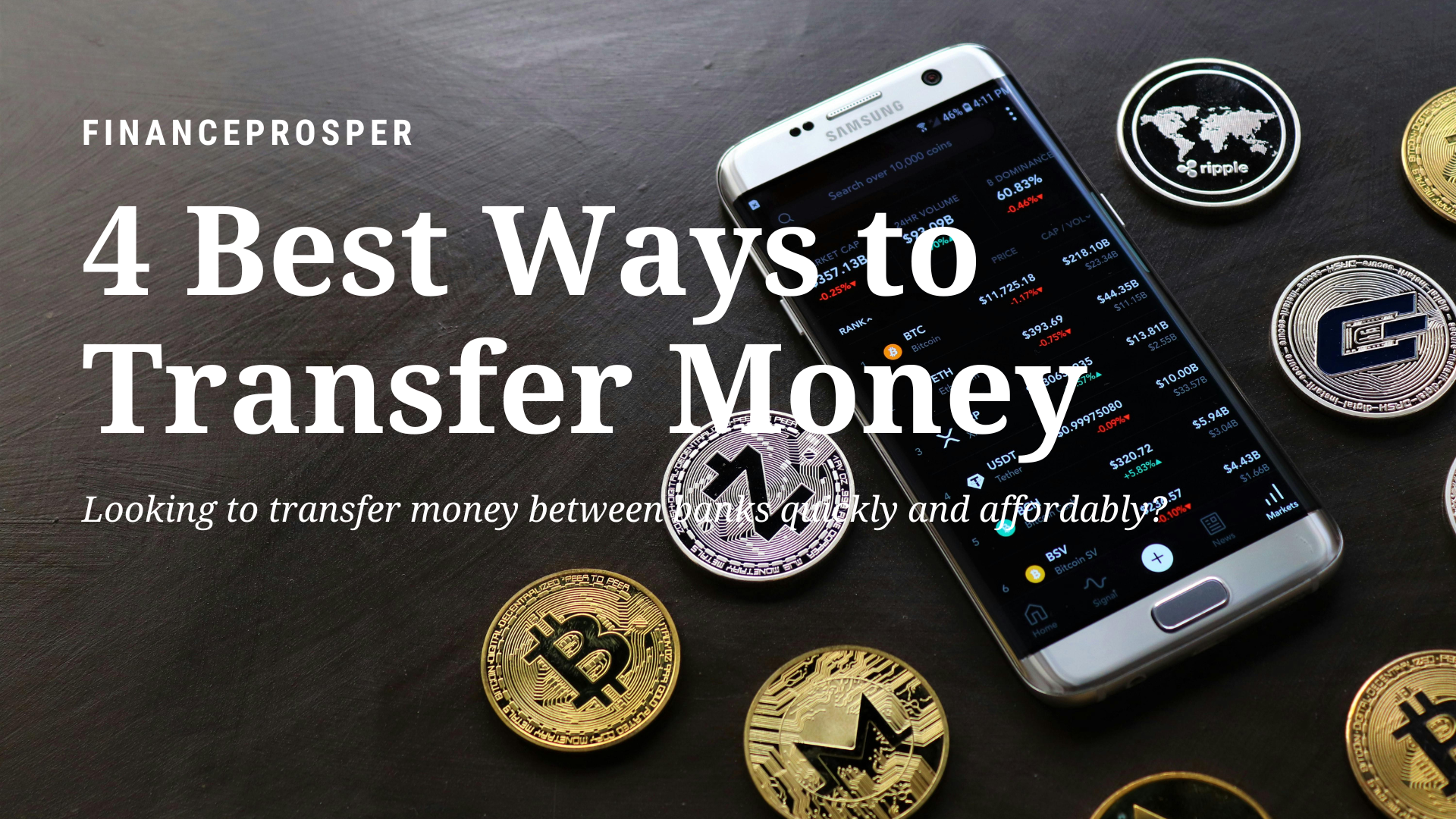
Looking to transfer money between banks quickly and affordably? Explore the fastest, safest, and most cost-effective methods to move your funds hassle-free.
Let’s dive in…
Key takeaways
- Through a variety of methods, including wire transfers, email money transfers, mobile apps, and check writing, you can move funds between accounts at several banks.
- Send money through a service that would be fastest, and cheapest, and inform the account of the recipient.
- Other competitors can merely offer cheaper, even faster deals than banks themselves.
Money can be sent to your accounts, or accounts of other people. Besides Zelle and Venmo, there are many other options to send money. The facility of transferring money between different banks helps to get funds to the right place. There are several ways for this.
Transfer costs and speed are good factors to consider when selecting the most appropriate way to transfer money, as these two factors are often closely related. The most expensive money transfer requires the least possible time.
What are bank-to-bank transfers?
A bank-to-bank transfer, also known as an external transfer, is the movement of money from an account at Bank A to another account at Bank B. Electronic external transfers that require the use of the Internet can expedite transferring money to someone else’s account because cash does not have to be moved between banks.
Things to consider before transferring money
When choosing a way to send money to another person, consider the following:
- Speed: Determine how quickly the funds must be transferred to the other bank.
- Compare fees: To send large sums of money over quickly, a wire transfer is necessary, though it is unlikely to be free. Other methods, like Zelle, can be both fast and free.
- Know their account details: For certain ways, you’ll need a recipient’s name, routing number, and account number. All Zelle needs, though, is the other person’s phone number or email address.
- Keep an eye out for transfer limits: While federal restrictions on savings account withdrawals are no longer in force, your bank may impose its own restrictions on the number of transactions in those accounts, and exceeding your bank’s limits on withdrawals could trigger a fee.
After choosing the speed, cost, and alternatives you have for sending options, you’re ready to make a money transfer.
Money can be transferred between banks in four different ways.
How to transfer money from one bank to another: 4 ways
1. Telegraphic transfers
Wire transfers are among the quickest ways to send money electronically between people via a bank or a nonbank firm like Wise, which was originally known as TransferWise.
For a domestic wire transfer, you will need the recipient’s name, account number, routing number, and, in some cases, their address. You can arrange domestic wire transfers online or in person at a branch or office.
Although wire transfers are faster and allow you to send more money than other ways, they are also more expensive. A Bankrate survey from November 2023 states that a domestic wire transfer costs $26.
Your bank may have a timeline during the week for wire transfers, which cannot be sent on weekends or bank holidays.
2. Third-party mobile applications
Besides banks, there are several other options for wiring money to anyone: PayPal, MoneyGram, Western Union, and many others.
Money transferred from PayPal to the client’s bank account is free. International transactions incur higher fees than domestic transactions, and there is also an exchange-rate fee for money transferred in foreign currency.
You can also use apps like Venmo, Samsung Pay Cash, Apple Pay, and Google Pay to send money to other people. Transfer times might range from a few seconds to several days, contingent on the method chosen. While standard transfers are usually free, quick transfers could incur a fee.
3. Email Money Transfer- EMT
Your bank likely has an app or website where you can access a service like Zelle or Venmo. This service allows you to send money online to another person using that person’s email address or cell phone number. I call it an email money transfer, or EMT.
Normally, such services are free and start working immediately, but you have a send volume limit on an account.
4. Write a cheque
A very old-fashioned way of transferring cash from one bank to another is to write a check and deposit it at a branch, online through a computer, through a mobile app, or by mail. A money order can be substituted, although some bank sites and/or apps are not designed to accept a money order for deposit.
Money can also be sent over through an official called a cashier’s check, which is then deposited like a standard check would be. There can be a fee involved in getting an official check or money order.
Step-by-Step Guide to Transferring Funds Between Banks
Here, the following, we provided an easy and simple step-by-step guide on how to send money across banks:
Step 1. Choose Your Transfer Option
- Bank-to-Bank Transfer (Wire Transfer): This is probably the safest, very easy method, but you have a chance of being charged.
- Transfer with Bank app or website: Most banks and websites let you make free money transfers with an online tool.
- Third-Party Services (like Zelle, Venmo, or PayPal): Great for quick transfers. Also suitable for small transactions.
Step 2: Gather needed information
You will need to get the following details from the recipient’s bank to start a transfer:
- Bank Name and Address
- Routing Number (for domestic transfer)
- Account Number
- SWIFT/BIC Code (for international transfer)
You will need the recipient’s email or phone number to access third-party apps.
Step 3. Log on to your online banking account
- Using your web browser, go to the website using your banking app or website.
- Confirm your verification that you are signed into the account that you are using to send the funds.
Step 4. Click on the Transfer Step
Online and through the app you will likely be prompted with whether to do ‘Transfer‘ or ‘Payments‘.
Ensure to choose ‘External Transfer’ or ‘To Another Account‘ if available.
Step 5. Share transfer information
- Beneficiary Information: Note down the details of the beneficiary’s bank.
- Amount to Transfer: Input the amount you would like to transfer.
- Transfer Date: You might choose to do the transfer immediately or schedule some time later.
Step 6. Verify transfer information
- Don’t make any spelling mistakes or a math error in the account and routing numbers.
- Fees will be applicable for the transfer or will take more than one business day.
Step 7: Confirm and Accept Transfer
- You have reviewed everything, now you can accept the transfer.
- And you will probably have to do multi-factor authentication; they are probably gonna request a code on your phone to approve the transactions.
Step 8: Hold off until this transfer is complete
- This may take a few minutes or days depending on the method the user has chosen for this transfer.
- Wire transfers typically take place the same day or the following business day. Zelle processes transactions in real-time, whereas traditional banks operate within a 1-3 business day timeframe.
Step 9. Confirm that the Transfer Status is Complete
- Your account balance as well as your transfer history will show that the transaction has been successful.
- If, however, there is a problem with your transfer, contact support.
Top Benefits of External Bank Transfers: Why They Matter for Your Finances
Without having to visit an ATM or a bank branch, external bank transfers enable you to move money immediately between banks or elsewhere.
For instance, an external transfer could move funds from a high-yield savings account at a bank that only accepts online to a checking account at a conventional bank with physical locations. Some customers want a checking account at a brick-and-mortar bank for the convenience of a branch, but online banking puts those savings rates greater than any that may be available at the local bank within reach.
A checking account can be transferred to another bank or credit union that is also offering other savings options so that a person can set different saving goals for their customers.
Top Tips to Prevent Fraud and Secure Your Transactions
Here are a few important things you must do to make your transfers safe:
- Check Recipient Details: Before you confirm a transfer, ensure that you’ve double-checked the account number, bank routing number, or any other information about the recipient. One small error can send your money to the wrong account.
- Secure Connections: A way of avoiding public Wi-Fi. Use your private and secure internet connection or a trusted mobile data connection to avoid your information being intercepted.
- Enable 2FA: Enable 2FA for the account of your online banking and payment app. This will add another layer of security while doing your transactions since it would ask for a second verification other than using your password, such as the code that will be sent to your phone.
- Check for Encryption: Make sure the website or app you’re using for the transfer is secure. Look for “https://” in the URL and a padlock symbol in the address bar to confirm the site encrypts your data.
- Watch Out for Emails or Messages: Be cautionary of phishing. Never open attachments nor click on links from any email or message that you did not request even though it came from your bank. Always type in the address of a website in your browser to access the site of your banks.
- Keep an Eye on Your Accounts: Watch your bank account and transaction history regularly to catch unauthorized transfers or suspicious transactions. Any suspicious activity should be reported right away to your bank.
- Set Up Alerts: The majority of banks provide transaction alerts via email or text message. Enable these to be notified about transfers or any form of transactions happening on your account in real-time.
- Use trusted transfer methods: Only use transfer methods that are known to be safe, such as bank wire, ACH transfer, and well-known mobile payment apps like PayPal, Zelle, or Venmo. Research the service if unfamiliar.
- Limit Sharing of Bank Details: Only share your banking details with trusted parties. If you’re making a payment to a company or person, make sure the transaction is legit before sharing any info.
- Use Strong Passwords: Use unique, strong passwords for your online banking and payment app accounts. To safely keep track of your logins, think about utilizing a password manager.
Also, if you apply all these tips, the possibility of fraud will significantly go down and your money transfers will be safe.
Conclusion
The quickest way to move money between accounts is through an external transfer. Some transfer options require some research to know the costs associated and just how long your money takes to arrive at its destination.
If you repeatedly transfer your money across accounts at high speeds, the creation of regular practice transfers will make you feel more comfortable with the process and thus will reduce the apprehension you may have had.
FAQs
1. How do I transfer money between banks?
You can send money via bank-to-bank transfer, third-party apps like Zelle or PayPal, or wire transfer. Just pick your method, give the recipient’s bank details, and follow the steps.
2. Do banks charge fees to send money between them?
Fees might apply based on the type of transfer as well as your bank. For example, most wire transfers come with some fees but with online bank transfers or third-party apps like Zelle, it is generally free.
3. How long will a transfer take to another bank?
Transfers may take a few minutes or a few business days according to their respective methods. For example, wire transfers may take from 1-2 working days, but services like Zelle happen almost instantaneously.



